450 Comparo: MXer Vs Enduro Vs Hybrid
Okay, so you’ve just signed up for a Transmoto Enduro Event. Your mates have reminded you that, seeing as these events are staged on private property, you’re welcome to ride anything … an unregistrable motocross weapon or a registered trailbike, or something between the two. But how do you choose the best bike for an event that takes in everything from gnarly trails to flowing grasstrack?
At a recent Transmoto 12-Hour, we put three 450s – a motocross weapon, a purebred enduro model, and a hybrid of the two – head-to-head-to-head to find out which is the best all-round dirt bike for whom and why.
This content was originally published in Transmoto’s print magazine in May-June, 2016 (Issue #56).
Fit for Multi Purpose
If your average ride takes in everything from gnarly trails to fast grasstrack, what’s the best all-round bike for the job? At the recent Transmoto 12-Hour, we put three 450s – a motocross weapon, a purebred enduro model, and a hybrid of the two – head-to-head-to-head to find out.
The Purebred Enduro Bike
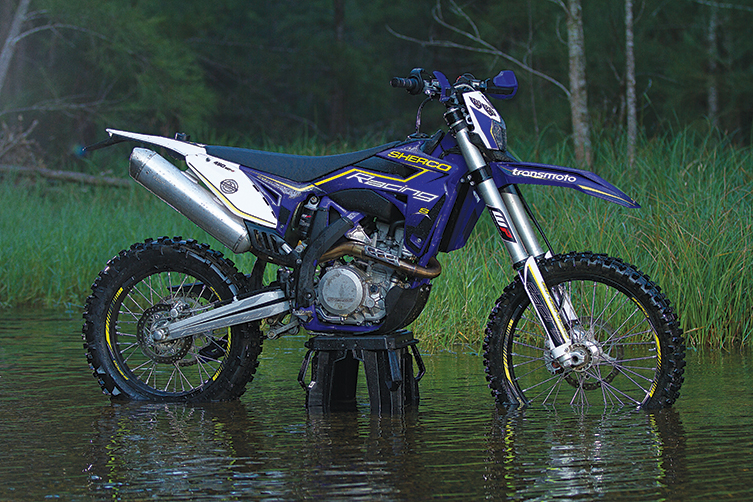
2016 SHERCO 450SEF-R
$13,290
For 2016, it gets engine, airbox and EFI upgrades to improve traction, plus mods to make the subframe and wiring more robust. And in Europe, Australia’s Matt Phillips is proving it’s a world-class giant-killer. But is it exciting enough for blokes who like to mix MX with trail?
The Purebred MX Bike
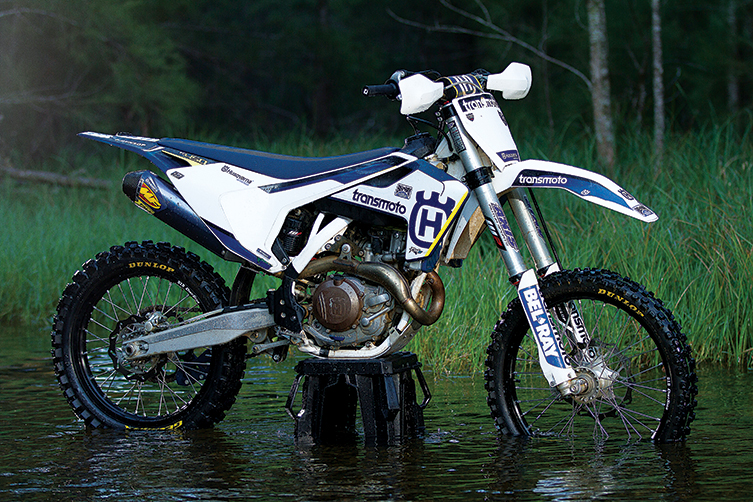
2016 HUSQVARNA FC450
$11,995
Rebuilt from the ground up for 2016, it’s more than 5kg lighter than its predecessor, and significantly more powerful and agile. Plus Australia’s Josh Strang is proving it’s a GNCC winner in the USA. But how’s it handle tight, rough terrain in the hands of an average rider?
The MX/Enduro Bike
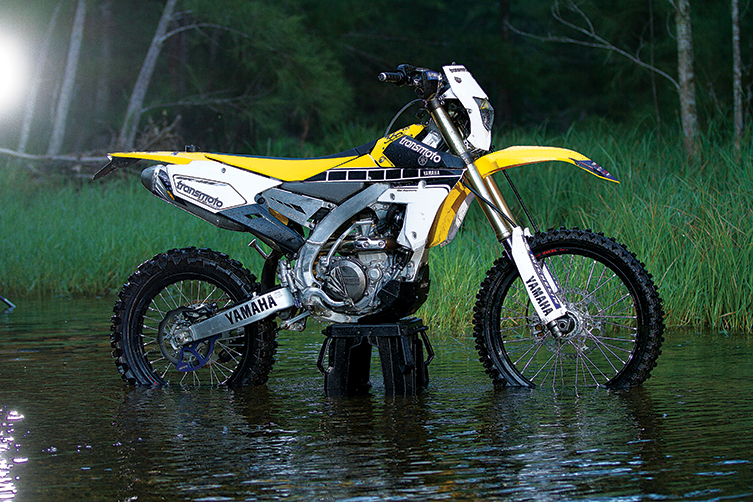
2016 YAMAHA WR450F
$12,999 ($13,199 – Anniversary yellow)
Australia’s biggest-selling enduro bike copped an injection of YZ450F DNA for 2016, which has seen it leap to the top of its class on the national racing scene. But because it’s an MX weapon adapted for off-road use, it this machine also user-friendly enough for trailriders?
There’s something inexplicably appealing about a machine that’s been designed and built for a very specific purpose. And that applies to motorcycles as much as any other man-made machine. But in the same way that a 250hp MotoGP bike might not serve you all that well for midweek commutes to work in between your licorice-laying weekend sessions at the track, purpose-built dirt bikes don’t always suit the variety of uses we like to put them to. A purebred motocross weapon may let you huck jumps and slam berms like a man possessed, but they can make off-road excursions feel like an accident waiting to happen. One the flipside, the silky-smooth and forgiving nature of a purebred enduro model is right at home in snotty terrain, but can quickly feel way out of its depth when you venture onto a motocross track with the thing.
So, if we’re to assume that you can only afford and/or justify one dirt bike in the garage at a time – a machine you plan to use for a combination of tracks and trails – it raises questions about compromise and adaptability. Do you look to adapt a rigid and explosive motocross bike to off-road use, or do you breath some fire into an enduro bike’s power delivery and suspension? Or, do you buy a bike whose manufacturer claims they’ve already performed these adaptations on your behalf?
Do you see what we’re getting at here, and how the Husqvarna, Sherco and Yamaha 450s fit into the picture? Yep, seeing as Transmoto’s project bike fleet includes three 450cc dirt bikes – a Husky FC450, a Sherco 450SEF-R and a Yamaha WR450F – we figured the wide variety of (private property) terrain at the 2016 Transmoto 12-Hour would provide us with the perfect testing ground to address these questions of fit for purpose, compromise and versatility. We enlisted the help of two very experienced riders, Stuart Morgan and Grant O’Brien, and after 12 hours of beating ourselves senseless on one of the roughest and most varied tracks we’d ever ridden, a clearer picture emerged about the relative strengths and weaknesses of these three machines. The experience also helped us decipher which machine is likely to best suit someone who wants their dirt bike to serve several purposes.
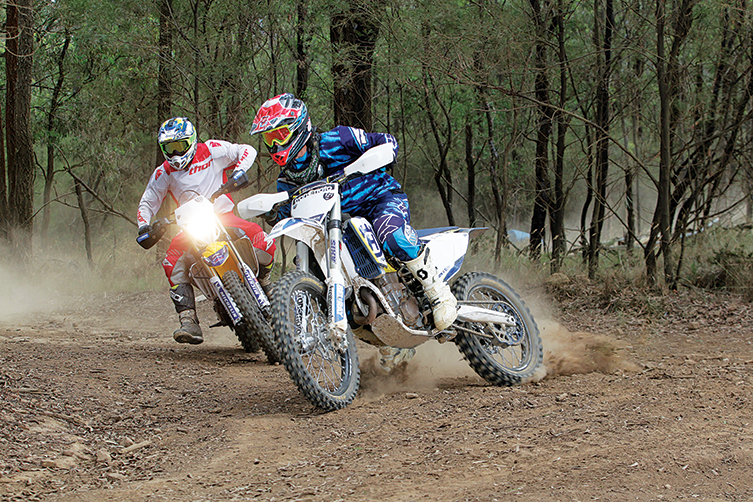
SITTING ON THE SPECIMENS
When it comes to ergonomics, the line that once existed between enduro and MX models has become so blurred, it’s almost non-existent. Which, when you think about, makes a lot of sense. Whether you’re on a motocross track, enduro loop or trail, a bike’s cockpit should be designed to put the rider in a position that creates a balanced chassis and good feel for the controls, and assists the bike to turn in a sure-footed, predictable way. So, how do our three machines differ to sit on?
The Sherco is definitely the most comfortable of the trio, and not just because its softer perch (which is very flat for an enduro bike) is better suited to rides that last longer than 30 minutes. The French machine is super-narrow between your legs, and its footpeg/seat/handlebar triangle puts you in a commanding position on the bike, whether sitting or standing. It also has a slightly more spacious cockpit than the other two machines, meaning it’ll happily accommodate taller riders without having to fit bar-raisers or taller handlebars. And its Brembo controls are light and slick, which only add to the SEF-R’s refined feel. Remove the hand guards, headlight and a few switchblocks from the bars, and it’d happily pass for a cutting-edge MX bike.
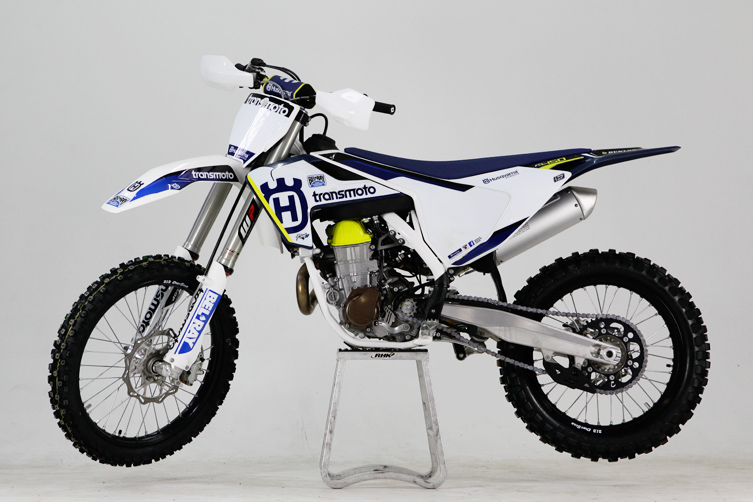
When it comes to streamlined bodywork, however, the Husqvarna comes up trumps. Combined with its flatter, firmer, grippier seat, the FC’s seamless plastics let you move effortlessly around the cockpit. Surprisingly, even though the 2016 FC450 makes its predecessor feel positively porky, it isn’t quite as slim as Sherco’s enduro machine through the girth and radiator shrouds, but its minimalist design screams purpose-built racer. As does its parsimonious 7-litre fuel capacity. Conveniently for those who value their knuckles, it comes with robust hand guards, while there’s a host of clever little design elements – think snap-off plastics, idiot-proof air filter, cleverly routed brakeline, self-cleaning pegs and gear-lever tip – which all reinforce just how much thought has been put into its creation.
Compared to these two purpose-built waifs, the Yamaha’s cockpit is noticeably wider. When you’re standing on the bike, it’s not that obvious. But the domed shape of the fuel tank (which is actually the airbox) and the prominent radiator shrouds (which incorporate intake ducts for the reverse-mounted engine) sure
makes it feel like you’re looking down on a much broader, thick-necked beast. Funnily enough, most of the whingeing about the Yamaha’s too-porky cockpit has subsided since the YZ250F and YZ450F started winning AMA and World MX Championships in the past two years. And given that the WR450F and WR250F share the same seat, tank and bodywork as their MX-specific YZ-F cousins, the enduro models have managed to dodge much of that criticism. The Yamaha’s switchblocks, controls and component spec might not quite be a match for the two European bikes’, but it makes up for that with superb fastener commonality and proven durability.
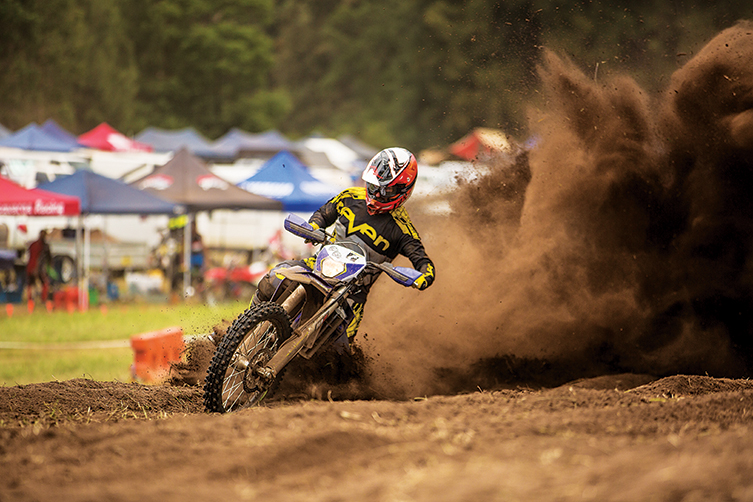
POWER FOR PURPOSE?
Sherco has only ever built enduro models. And that’s probably why the power delivery from its flagship 450SEF-R feels so purpose-made for off-road use.
It’s broad, strong and torquey, and comes on in such a linear and progressive way that finding traction becomes a much easier task. It’s a more forgiving and versatile style of power than the other two bikes, both of which are (or were originally) designed for motocross. That means you don’t have to be as precise with throttle inputs on the Sherco to keep its rear wheel hooking up and driving. And the rougher the terrain got at the 12-Hour, the more the Sherco’s easy-to-manage power endeared itself to the increasingly fatigued bloke onboard. Whether you were in flowing singletrail, grippy grasstrack or slick rocks at the creek crossings,
the Sherco was the easiest bike to keep tracking straight. And for the really technical or slick sections, it’s bar-mounted dual-map switch – one of the few genuinely on-the-fly units on the market that makes a noticeable difference in the power delivery – was an added bonus.
After a lap aboard the super-smooth Sherco, we all expected that jumping straight onto Husqvarna’s purebred MX bike would be a bit of a culture shock. And it was. There’s just no hiding the fact that 63hp will boost you out of turns with eye-watering enthusiasm. This thing was in its element on the loamy grasstrack sections of the 12-Hour loop, but when the terrain got tight and technical, you needed to keep your throttle control wits about you. Once you adapted to the punchier, more responsive nature of the MX powerplant and learned to short-shift at every opportunity, the difference between the Sherco and Husky was not as large as we’d initially expected. And that’s largely because the 2016 FC450’s all-new engine is much better suited to off-road use than its predecessor. It’s so much broader, torquier and smoother, and will be a superb platform for Husky’s (and KTM’s) 2017 enduro model that will no doubt come with this new-generation donk. That said, the light flywheel and tall gearing really worked against the Husqvarna in the tighter, stop-start terrain, and if you weren’t constantly attentive with your clutch finger, it was easy to stall the engine (which is when we came to appreciate the FC’s electric start!). Flicking the bar-mounted map selector switch to the mellower curve certainly helped pacify the power delivery in the tight going, but there’s no doubt the 13/48 gearing is too tall for the bush (Australia’s Josh Strang tells us that he’s running a shorter 14/51 or 14/52 sprocket combo at most GNCC tracks).
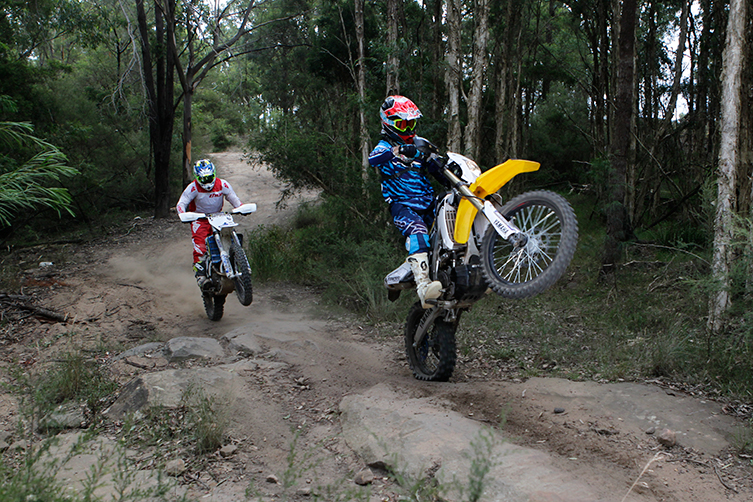
With the 2016 WR450F, Yamaha’s engineers have done a great job of making the YZ450F’s prodigious grunt smoother and more manageable for the bush. So that means the nature of its power delivery sits somewhere between the Sherco and Husqvarna, right? Yes and no. With the standard muffler fitted, yes. With the free-flowing FMF/GTYR muffler we used at the 12-Hour, no. When you open the taps on the WR450F, it still feels like a motocross mill in disguise, and that’s very different to the super-linear curve that was its predecessor’s trademark. So, like the Husky, we all found that short-shifting the Yamaha helped tame that punch and get
the rear wheel hooking up more effectively. And when the track got even rougher in the afternoon, we resorted to uploading our pre-programmed Traction Map into the bike’s ECU, and then wondered why we hadn’t done it earlier. By taking the edge off the throttle response mainly through the bottom-end and mid-range, this
map creates a much more progressive power curve and helped get drive out of slow corners. It also kept the bike’s rear-end tracking straighter through the huge sand whoops, but still let the thing boogie at higher revs, which came in handy on the smoother, grippier grasstrack.
This experience reinforced just how convenient Yamaha’s affordable ($398) and easy-to-use Power Tuner is. To our way of thinking, it’s the first genuine accessory that 2016 WR450F owners should be buying.
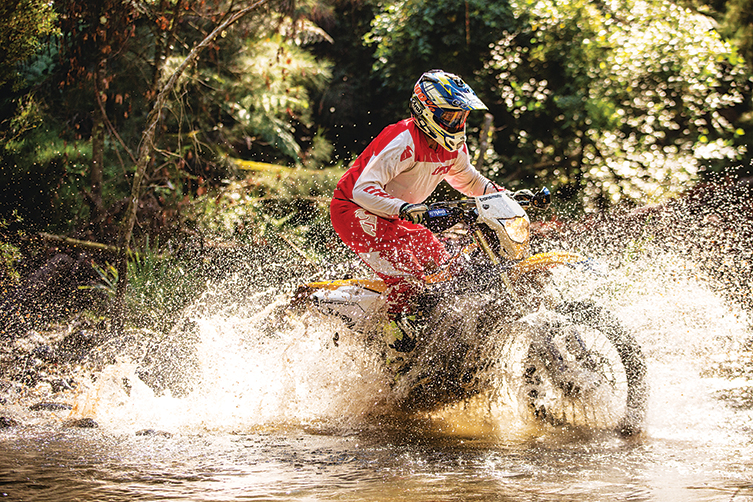
HANDLING TERRAIN HOW?
By lunchtime, when the 12-Hour track was pretty damn rough, the fact the three of us all gravitated towards the Sherco speaks volumes about how forgiving its WP suspension package is. Of the three machines, the 450SEF-R clearly delivers the plushest overall ride, and that was exaggerated by the softer seat (while seated, anyway). By soaking up the small chattery bumps, exposed tree roots and loose rocks, it gave you the confidence to relax more in the saddle and let the bike do its thing beneath you. The combination of the light and nimble feel of the chassis, predictable front-end, and super-tractable power, made the Sherco a pleasure to ride for a greater majority of the 12-Hour track. When the bumps turned to man-sized whoops by mid-afternoon, however, the Sherco’s fork and shock did start to feel a little soft and under-gunned. It retained good bottoming resistance on all but the biggest hits, but by using more of its suspension stroke than it needed to at both ends, it didn’t let you hit the larger bumps with the same feeling of invincibility. Dialling some extra compression damping into both ends via the clickers certainly helped it sit up in its stroke, but that came at the expense of small-bump compliance you needed elsewhere on the track.
Taking a firmly sprung motocross bike into gnarly trails always calls for caution. And it comes as little surprise that, at slower speeds, the Husqvarna was more inclined to deflect off square edges, roots and rocks than the other two bikes. And that can take its toll on your arse and hands and headspace after a few pounding hours in the saddle. That inherently firm ride at both ends does force you to slow down on choppy singletrack and/or ensure the bike is more upright when hitting a series of obstacles. But what surprised us all was how confidence-inspiring the Husky’s suspension began to feel when the bumps got even bigger in the afternoon. When confronted with waist-deep whoops that made the Sherco’s suspension wallow, the lightweight Husky came into its own. It let you charge much more aggressively without getting out of shape.
The harder you pushed the FC chassis towards the end of the event (when the track resembled a motocross track between trees), the better it felt.
Given that the Yamaha uses the same fork and shock as the YZ450F, but comes with changes to springs and valving to adapt the suspension to off-road use, you’d expect its ride to be somewhere between the other two. And it is. The Yami’s Kayaba fork and shock are plush enough for the average sit-down punter to plod along at trail pace, and yet both ends will resist bottoming in the hands of a fast 90kg rider. That versatility could be put to really good use around the 12-Hour track, which dished up everything from chopped-out trail to whoops so big, it was better to jump than blitz them. In really tight terrain, it did surprise us all just how much bigger and heavier the Yamaha felt to flick from side to side – due in part to its beefier ergos and taller ‘shoulders’. But what the bikes gives you in return is amazing chassis stability and predictable steering at higher speeds.
RELATED CONTENT
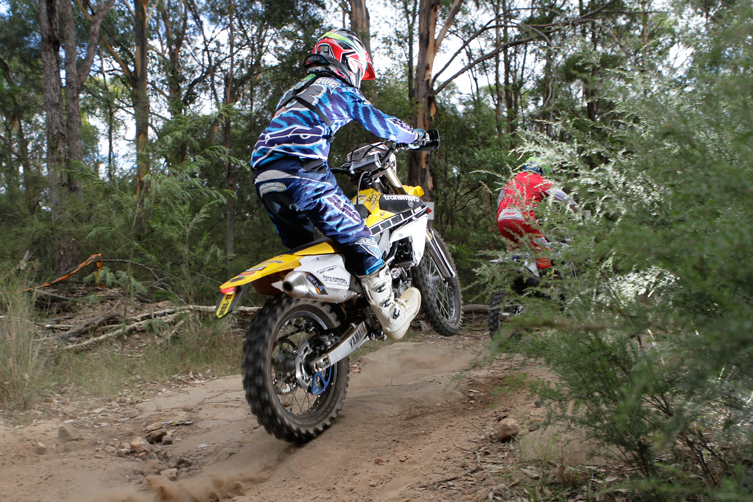
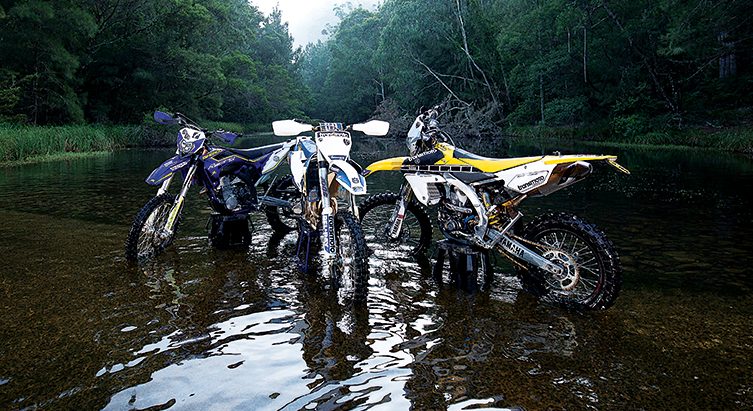


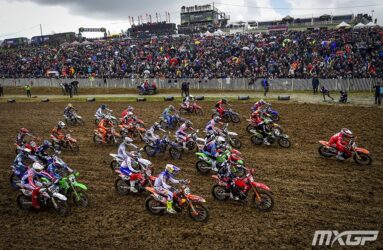


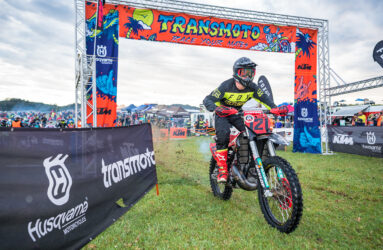


Be the first to comment...